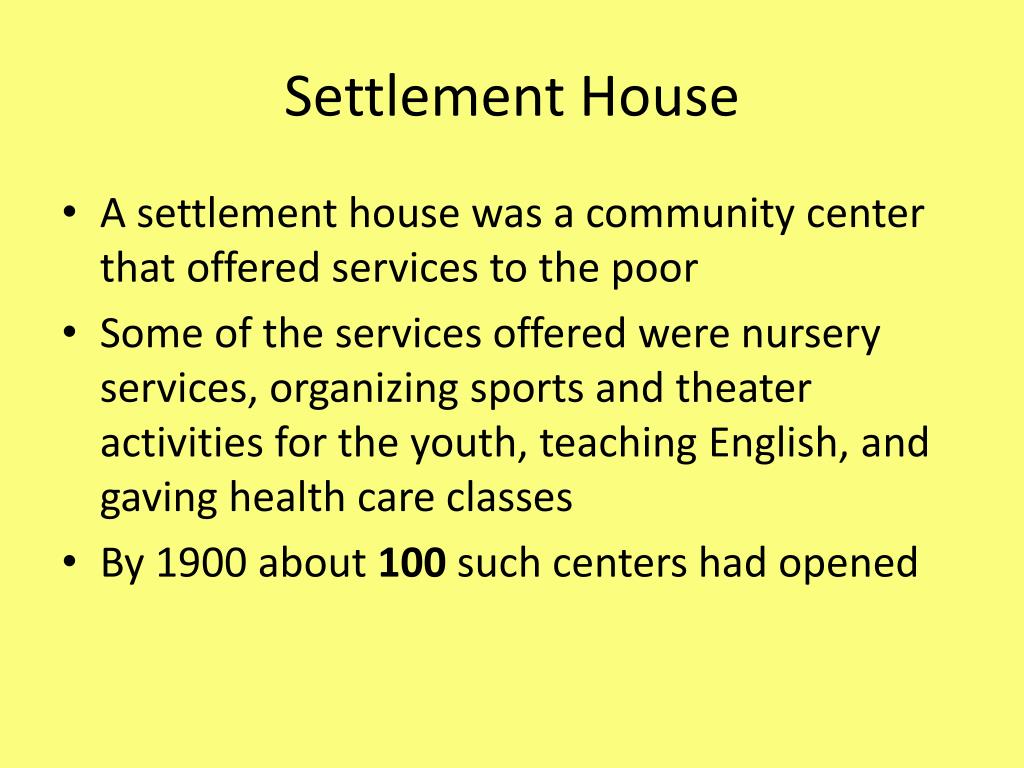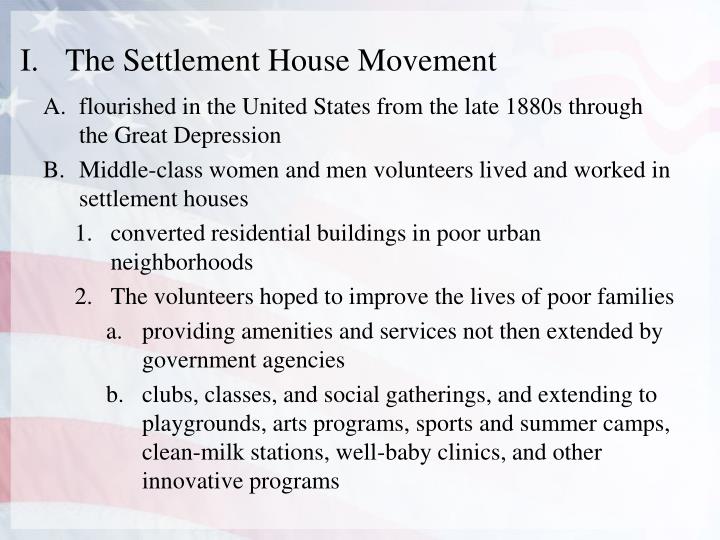Table Of Content

Some societies use Oxford Academic personal accounts to provide access to their members. District councils and city federations formed in Chicago, Boston, New York (1894 and ff). Period of district councils stimulated and supported by Community Chests. National negotiations finally establish that district councils are appropriate for Chest or Planning Council support.
More House Residents and Leaders
The pair visited Toynbee Hall, a settlement house on the city’s East End that provided much-needed services to poor industrial workers. Addams vowed to bring that model to the United States, which was in the early years of escalating industrialization and immigration. By 1901, hundreds of settlement houses dotted the crowded neighborhoods of America’s rapidly expanding cities. The settlement house movement was founded in London in 1884 and earned their name from the fact that their mostly college-educated, (and eventually) mostly female staff also lived on site, ‘settling’ among the local communities they aimed to serve. Addams, who came to understand political corruption while working in Chicago, saw that political democracy had failed to eliminate poverty and class distinctions; workers had no place to congregate, to organize, to enjoy cultural or social activities, or to learn. The second motivation she saw for the settlement was to answer a natural longing of people for fellowship and sympathy—a term that recurs in much of the writing of settlement leaders.
Watch the Petersen Museum's massive renovation in this time-lapse video
As one volunteer explained in an 1895 Wellesley Magazine editorial, “when it comes to the actual activities, each hour of each day, of each member of a settlement family is so wildly divergent,” that it would be impossible to describe in a short article. In addition, Hull-House members carried on an active program of research. They publicized their results widely, attempting to create an atmosphere conducive to governmental and legislative reform. Today, settlements are still community-focused organizations, providing a range of services including early education, youth guidance and crime intervention, senior programs, and specialized programs for young people who have "aged out" of the foster care system. Since they are staffed by professional employees and students, they no longer require that employees live alongside those they serve.
National conferences
The movement also drew in lesseducated middle-class women who were concerned about the poor and felt a personal need to help them. The American settlement movement diverged from the English model in several ways. More women became leaders in the American movement; and there was a greater interest in social research and reform. But probably the biggest difference was that American settlements were located in overcrowded slum neighborhoods filled with recent immigrants. Working with the inhabitants of these neighborhoods, settlement workers became caught up in searching for ways to ease their neighbor’s adjustment and integration into a new society.
French eclectic might blend aspects of Craftsman, Cottage, or other styles to create a hybrid form while still retaining some of the rustic elements of French provincial homes, such as steeply raked grey-tiled roofs and brick chimneys. Normandy's provincial homes featured narrow-eave, steep-hipped roofs, with side-facing gables and sometimes an L-shaped plan placing the front door at the junction of the two wings. Dormer windows often project through the eaves, and these rustic-styled homes are finished in stucco, stone, or brick.
American Colonial
Front-facing triangular gables sometimes break up the rectangular linearity of this style. In the 1940s, Frank Lloyd Wright, in particular, popularized a more accessible and site-specific style of Modern architecture, which softened some of the brutalism of earlier incarnations. Stucco exteriors are often painted in bright, earthy tones, and flat roofs reflect the excessive summer heat.

Helped develop Federal Music Project, which provided quality teaching to group serving agencies. The United Nations was viewed with great hope, and centers supported it through informational materials and educational seminars. Federation was accredited to the Economic and Social Council of the UN as a Non-Governmental Organization, Class II. It has participated ever since in activities of the UN and its various bodies, and with the U.S.
Support to local organizations and self-help efforts is a priority, with a high percentage of neighborhood centers restudying their neighborhoods and doing program reviews, focusing agency resources on neighborhood-inspired action. Hundreds of neighborhood people have participated in the biennial Legislative Seminars since their establishment in 1946, learning first-hand the link between them and their Washington representatives. The War on Poverty which followed proved both a boon and a challenge. They did respond to this challenge, and by 1968 a quarter of the local board members were neighborhood residents.
Institutional account management
Ethnic enclaves sheltered immigrants who were experiencing isolation, new customs, and a strange language. The Settlement House Movement is perceived as a major influence on the emergence of the social work profession globally. Yet, historical research on this movement in social work, and in particular, the transnational translation of this idea, is very limited.
Gradually organizations such as the Young Men's Christian Association, summer camps, neighborhood youth centers, and other local and national agencies were established to carry on similar work. The settlement house movement gradually broadened into a national federation of neighborhood centers. By the early twentieth century, settlement houses were beginning to cooperate with, and merge into, "social work." The settlement house movement led the way to community organization and group work practice within the newly proclaimed profession of social work. Established in large cities, settlement houses were privately supported institutions that focused on helping the poor and disadvantaged by addressing the environ-mental factors involved in poverty. The basic settlement-house ideal was to have wealthy people move into poor neighborhoods so that both groups could learn from one another.
Return to Gush Katif: A determined movement emerges to resettle Israelis in Gaza - The Times of Israel
Return to Gush Katif: A determined movement emerges to resettle Israelis in Gaza.
Posted: Sun, 03 Dec 2023 08:00:00 GMT [source]
There is much unfinished business for neighborhood centers in local areas. Their programs are needed, not so much to provide universal coverage in services as to be the “experimental stations” to develop and test ideas for the future. Blueprints are still unfinished for a continuum of support services for the aged; preparation for responsible parenthood; job training with entry into the world of work; low-rent housing for families; citizens’ advice bureaus.
Victorian is something of a catch-all term for a number of styles, including Gothic Revival, Italianate, Second Empire, Romanesque, Stick Style, and Folk-Victorian, amongst others. These home styles have in common their highly decorative, even fussy, exteriors and their eclectic remodeling of English and European romanticism. Landscaping in the grander residences in this style might incorporate English-flavored elements such as rose-beds, walled gardens, and fruit trees.
During the war she spoke throughout the country in favor of increased food production to aid the starving in Europe. After the armistice she helped found the Women’s International League for Peace and Freedom, serving as president from 1919 until her death in 1935. Typically, access is provided across an institutional network to a range of IP addresses. This authentication occurs automatically, and it is not possible to sign out of an IP authenticated account.
It was soon followed by Hull House in Chicago, founded in 1889 by the national leader of the settlement house movement and influential social reformer, Jane Addams. Many settlement workers joined the movement out of a strong conviction that effective social welfare programs were the only thing that could prevent the pernicious development in the United States of a European-style entrenched social class system. A distinctive feature of the early years of the settlement movement was “residency.” By design, staff and volunteers lived communally in the same house or building, sharing meals and facilities, working together and spending some or all of their leisure time together. This arrangement fostered an exciting environment in which university-educated and socially motivated men and women enjoyed the opportunity to share their knowledge, life experiences, ideas and plans for the future. Working and living together, even for short periods, the residents of a settlement house bonded around specific projects, collaborated on social issues, formed close friendships and experienced lasting impressions they carried with them for a lifetime. Settlements were organized initially to be “friendly and open households,” a place where members of the privileged class could live and work as pioneers or “settlers” in poor areas of a city where social and environmental problems were great.
Through their connections, the women and men who ran the settlement houses were also able to influence political and economic reforms. In this time when great dreams seem to have been abandoned, what can be learned from a century of heroic settlement effort? On the urban frontiers, neighborhood centers performed illustriously in responding to the social and educational needs of each new wave of immigrants. The settlement movement left a legacy for the whole nation through its common effort for social reforms, insuring that life for all has become more safe, fulfilling, and humane.
Progressive Era settlement houses fostered the activism and intellectual creativity, as well as the conflicts, that would profoundly shape American modernity in the 20th century. For the growing population of newly minted women college graduates, settlement work offered an unprecedented opportunity to put to active use the education only recently made available to them. The impulse to share took on its most important institutional form with the establishment of the International Federation, which held its first conference in London in 1922. U.S. representatives have participated in all the international conferences, held every four years except for war’s interruptions, and have been active in the International Federation. The U.S. settlements were hosts to neighborhood workers who attended the Washington International Conference on Social Welfare in 1966, and set up a “seminar on wheels” which included some Canadian centers on its itinerary. The centennial year of 1986 will reach a fitting high point when the International Federation will hold its conference in New York in October, a joint enterprise with the United Neighborhood Centers of America and the United Neighborhood Houses of New York.
No comments:
Post a Comment